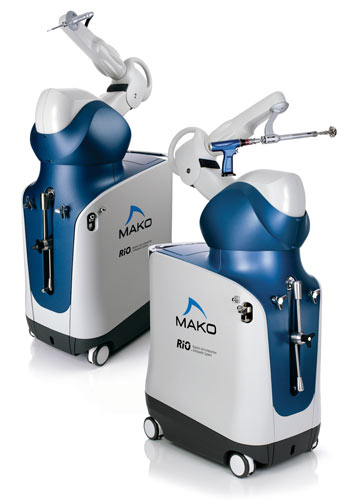Specialties

A high‐tech computer guidance system is enabling specially trained orthopedic surgeons to perform knee and hip replacement surgeries with pinpoint accuracy. The FDA‐approved MAKO robotic system uses a 3D virtual model of the patient’s unique anatomy based on a preoperative CT scan and a robotic arm to assist surgeons in planning and performing an ultra-precise procedure. It is customized for each patient.
Dr. Geoffrey Westrich characterizes the system as a useful tool to optimize joint replacement surgery. "Overall, joint replacement is highly successful in relieving arthritis pain and improving quality of life," says Dr. Westrich, Director of Research Emeritus in the Adult Reconstruction and Joint Replacement Service at Hospital for Special Surgery. "Studies have shown that optimal alignment and positioning of the implant are critically important for the longterm success of a joint replacement. As such, the extreme accuracy provided by Mako robotic-assisted surgery could potentially improve the longevity of a knee or hip replacement. This is an important consideration, especially for younger patients."
Robotic-Assisted Surgery for Younger Patients
Dr. Westrich says he is seeing more patients in their 40s and 50s who refuse to let arthritis slow them down. The main concern for patients in this age group is that the implant may wear out over time. Although a knee or hip replacement can last 15 to 20 years, or even longer, it doesn’t last indefinitely. For younger individuals, in particular, robotic-assisted surgery has made joint replacement an attractive option, as it could prolong the life of the implant, according to Dr. Westrich.
The 3D image of the patient’s anatomy, along with the robotic system, allow for pinpoint accuracy in aligning and positioning the artificial joint replacement. MAKO uses 3D, high-definition visualization, along with a robotic arm to guide the surgeon with visual, tactile, and auditory feedback.
Before surgery, CT scans are taken of the patient’s joint to assist surgeons in planning the procedure. During surgery, the surgeon controls a robotic arm that uses computer‐guided mapping software, similar to GPS, integrated into the surgical instruments.
The digital tracking system constantly monitors and updates the patient’s anatomy and enables the surgeon to make real‐time adjustments to optimize implant placement, alignment, ligament balance and joint motion. This provides each patient with a surgery tailored to his or her individual anatomy.
Goal: A Longer‐Lasting Joint Replacement
With more accurate alignment and positioning, the implant will experience less wear and friction, and it could ultimately last longer, according to Dr. Westrich, who notes that studies will be needed to confirm this over the long term.
He says the precision of the robotic‐assisted procedure also enables more bone to be preserved and offers more protection to the surrounding soft tissues, an advantage in the event another knee replacement is needed down the road.
The MAKO robotic system is currently used for total knee replacement, partial knee replacement and total hip replacement surgery.
